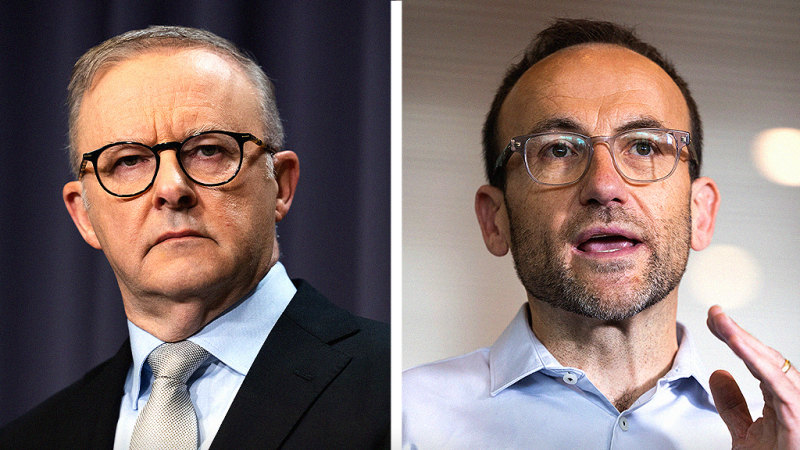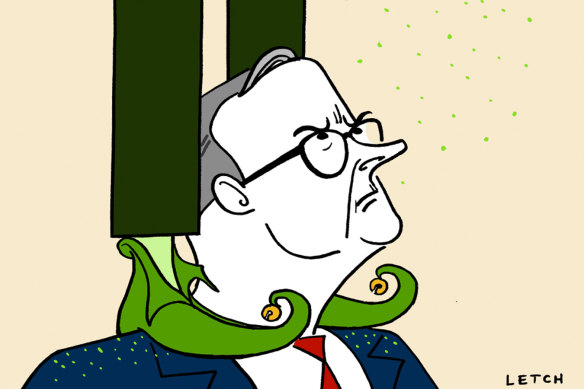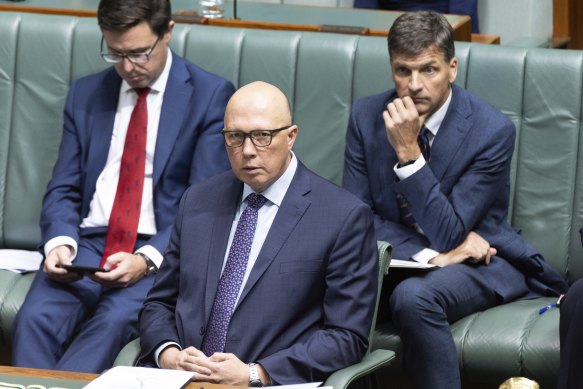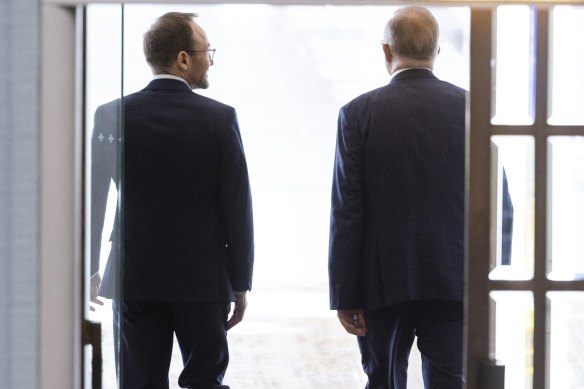A sharp jab from Anthony Albanese proved again this week that he knows very well how to needle the Greens until they burst. Taking a question from Greens leader Adam Bandt on housing policy, the prime minister was full of derision for Bandt for urging the government to organise a national rent freeze with the states.
“One of the things I won’t do is promise absolute pixie dust,” Albanese shot back. “Because that’s what that is.” With one big constitutional reform under way this year with the Indigenous Voice, he argued, he was not about to seize control from the states and set rents.
Illustration by Simon LetchCredit:
The Greens fumed over that quip and fired off a response as soon as question time was over. At a minimum, Bandt said, the prime minister could put the issue on the national cabinet agenda and get the states to act.
“The prime minister’s claim of ‘pixie dust’ is bull dust,” he said.
Whatever you call the dust, there’s plenty of it between Labor and the Greens right now. In fact, they’re like two utes doing circle work in a dry paddock – a brown cloud swirls above them as they rev hard to compete in parliament. Yet, the strange thing is that every now and again the two leaders will come to a halt, step out of their vehicles and shake hands on a deal.
Sidelined: Opposition Leader Peter Dutton’s silence has been proof of a problem.Credit:Alex Ellinghausen
The fight over housing is the biggest clash between the two parties, and it will run for months. Albanese expresses disbelief at the way the Greens would rather block the government’s $10 billion Housing Australia Future Fund than get something set up as soon as possible. Yet the Greens have a point: the fund is merely a cashbox to be managed by the Future Fund so its annual earnings can be spent on affordable housing. The fund sounds big, but there are real questions about how many new homes it can finance.
Bandt is happy to slug this one out for as long as it takes. He and the party’s housing spokesman, Max Chandler-Mather, are appealing to young voters who feel shut out of the housing market and hate paying high rents – the key reason for that “pixie dust” claim about a national rent freeze. They can campaign on this all the way to the federal election, due in early 2025, in the knowledge they have another pillar to their platform beside climate change, opposition to the AUKUS deal and offering asylum to refugees.
Albanese looks completely unruffled. He believes Australians want an outcome from parliament rather than an endless argument. On this issue, both leaders believe they have the winning case, which means neither is in a hurry to cut a deal.
Greens leader Adam Bandt and Prime Minister Anthony Albanese.Credit:Alex Ellinghausen
There is an old and unwieldy word for what is going on here – co-opetition. Compete when you need, co-operate when you must. Stepping back from the housing dispute, the real story of the Greens is about a new pragmatism that breaks with the past.
The Albanese government is not yet a year old and it has gained support from the Greens to pass industrial relations laws, put price caps on coal and gas, legislate a target to reduce carbon emissions by 2030, set up the $15 billion National Reconstruction Fund and turn the “safeguard mechanism” into a more powerful way to cut emissions. Bandt wanted more from Labor on each of these; in the end, he made sure to get an outcome rather than an impasse.
The passage of the safeguard mechanism is being overshadowed by other news – for some, it’s the Indigenous Voice; for others, it’s Gwyneth Paltrow’s skiing accident – yet it should not be shrugged off as a minor advance. It is the most significant step forward in federal law to cut emissions since the deal between Labor and the Greens on the Clean Energy Act of 2011. That says a lot about a dozen years of dysfunction.
Albanese has produced an old-fashioned negotiation rather than the alliance Julia Gillard struck as prime minister in a minority government. This is no small feat for anyone who remembers the failure of the Carbon Pollution Reduction Scheme in 2009, the repeal of the Clean Energy Act in 2014, the work by conservative Liberals to sabotage the Clean Energy Target in 2017 and the similar destruction of the National Energy Guarantee the next year, along with the coup that installed Scott Morrison as prime minister.
Even the climate protestors outside Parliament House seem relieved. “It’s better than nothing,” a few of them said of the safeguard mechanism on Thursday morning. After all, Bandt negotiated a hard cap on emissions and Energy Minister Chris Bowen was willing to toughen the scheme within the bounds of the Labor policy pledge at the election, so both sides can claim a reasonable result.
Australia, take a bow. The country has just enacted a cut to emissions without a government schism or a leadership spill. If you choose, you can switch off the news from Canberra and go back to wondering whether the actress or the optometrist was uphill on the skifields of Colorado.
The invisible man in all of this is Peter Dutton, who cedes the centre stage to the Greens by saying “no” to most government policies as opposition leader. Dutton shunned the limelight while his Liberal colleagues were fighting the NSW election campaign and the Aston byelection in Victoria. He has asked a few questions in parliament but, for the most part, has been the dog that did not bark in the Sherlock Holmes story: his silence has been proof of a problem. Put simply, the Liberal Party knows its federal leader costs them votes.
This takes the Liberals and Nationals out of the action and turns the Greens into the de facto opposition on some of the biggest decisions in parliament. The Liberals want to raise the spectre of a Labor-Greens alliance, of course, but they are doing it with a vote of no confidence in their own leader.
While Dutton hides, Bandt is vocal every day. It is almost as if the parliament has a new opposition leader.
Cut through the noise of federal politics with news, views and expert analysis from Jacqueline Maley. Subscribers can sign up to our weekly Inside Politics newsletter here.
Most Viewed in Politics
From our partners
Source: Read Full Article



